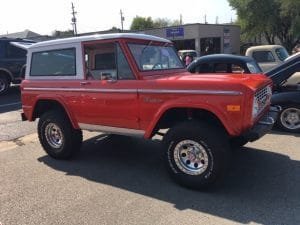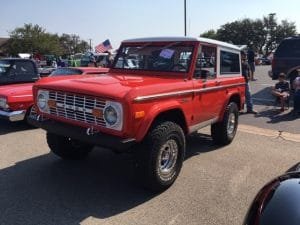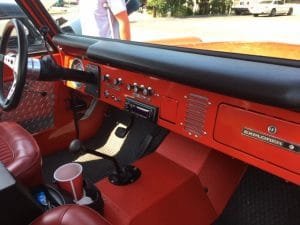Featured is a 1974 Ford Bronco. This first generation Bronco is very popular among collectors who really appreciate it’s sturdy construction, simplicity and four wheel drive. The first Generation Ford Broncos are quite possibly the most recognizable vintage SUV of all.

Ford brought out their first Bronco model for the 1966 model year. At that time vehicles of this nature were not being manufactured by the Big Three. Ford was the first American automaker to jump into this niche.The market was growing for sport utility and off road vehicles.
Ford Bronco’s competition when the model was first introduced was essentially the Jeep CJ, International Harvester Scout, Toyota, and Land Rover. The market at that time was about 40,000 vehicles per year. Ford decided to enter this market by adding more refinements and increased power from what was available in 1966.
While the first year 1966 Bronco, which had a base price of around $2,200, was said to be an all purpose vehicle, in actuality that first model was an off road vehicle and was equipped as such. Ford produced just under 24,000 Broncos for the 1966 model year.
Ford Bronco Style and Performance
The 66-77 Ford Bronco’s unique style and excellent off-road performance led it to become a cult classic with a very dedicated following. It’s use by race car builder Bill Stroppe for use in long-distance off-road competitions only helped to solidify the Bronco as an American icon.
The original Bronco became an icon of an adventurous lifestyle and off-road capability. Available options during the 10-year production of the first Bronco included a CB radio, an auxiliary gas tank, a power take-off, a winch and a post-hole digger. The Ford Bronco had front bucket seats, a rear bench seat and a tachometer. Plenty of options were available including an extra fuel tank, a winch, ans a snow plow.
Bronco’s Long Production Run
The Bronco lasted in production for thirty years ending in 1996. The model had five generations during this run. The first generation ran from 1966 to 1977.
1974 Ford Bronco Specifications
In 1974, the Bronco had two engine options. The base engine was Ford’s popular 200 cubic inch Inline-Six. The stronger engine was the 302 cubic inch V8. That V-8 had been an option on the Bronco since 1969. Horsepower was 120 and 125 respectively and torque was 190 and 243 respectively. Top speed was rated at an average of 91 MPH.
Transmission was a four wheel three speed manual. An option was a three speed medium-duty C-4 automatic transmission. 1974 was the first year that the Ford Bronco had a lighted shift selector.
 Dimensions include a 92.0 inch wheelbase, overall length 152.1 inches, width 69.1 inches, height 70.5 inches. Curb weight 3,350 lbs.
Dimensions include a 92.0 inch wheelbase, overall length 152.1 inches, width 69.1 inches, height 70.5 inches. Curb weight 3,350 lbs.
Unleaded fuel and catalytic converters were not added to the Bronco until the 1975 model year.
1974 Ford Bronco production totaled 25,800 vehicles.
Additional related Auto Museum Online articles are found on the links below…
1966 Ford Bronco / The First Bronco
Reference material for his article includes..Ford bronco: A History of Ford’s Legendary 4×4 by author Todd Zuercher..Ford Bronco, 1966-77 by R.M. Clarke..Bronco Club of America..
1974 Ford Bronco Collector Popularity
 At this time first generation Ford Bronco’s are very popular collector vehicles. These models represented the time when the Big Three automakers took the plunge into the sport utility vehicle market which was dominated by just a few brands. The first generation Ford Bronco’s were rugged and good looking and were a hit for Ford.
At this time first generation Ford Bronco’s are very popular collector vehicles. These models represented the time when the Big Three automakers took the plunge into the sport utility vehicle market which was dominated by just a few brands. The first generation Ford Bronco’s were rugged and good looking and were a hit for Ford.
Current asking prices for restored examples in excellent condition should be found in a range of $60,000 into the six figures. Originality, exact model package and age of restoration are value determiners.
(Article and photos copyright Auto Museum Online)

